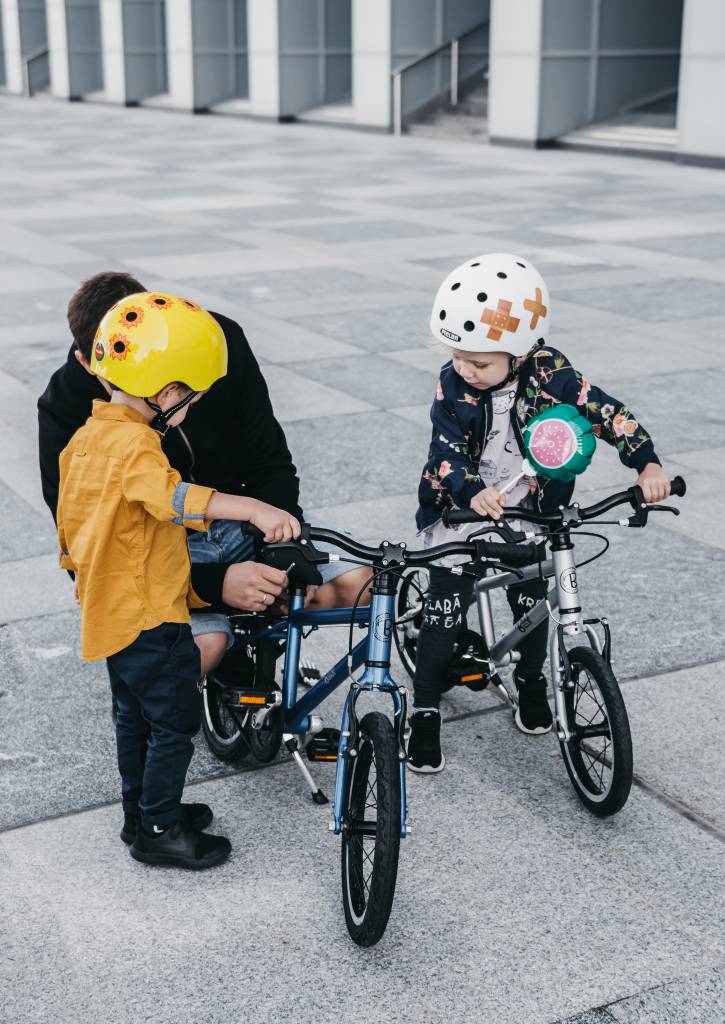How To Teach Kids To Ride A Bike
We strongly recommend that a kid first learns to handle a balance bike. This exercise teaches the essentials of steering and simple balance without the hassle of pedals getting in the way. Our experience strongly suggests that kids who have ridden a balance bike before their first bicycle learn to pedal tremendously faster than kids who haven't used a balance bike.
We do not advocate the use of balance wheels on bikes because it keeps the bicycle in a rigid upward position, thus keeping the kid from learning to balance on his own. Which is the sole purpose of the exercise.
Most children will be ready to learn between two and a half and three and a half years of age. If they’re not ready, it’s usually pretty obvious right away and they won’t get the hang of moving the pedals in circles quickly.
If children see other kids riding, they’ll get some sort of idea about turning the pedals. Remember, children are hardwired to learn to walk and run, but not to cycle.
Choose a suitable area
It’s important to choose a suitable area for their first lesson. It can be tempting to choose soft grass as it’ll give a softer landing, but this is actually harder to pedal on.
What you actually want is a smooth and fairly flat tarmac surface that’ll let the child get some rolling momentum, ideally with plenty of space so the child can roam around, and of course away from traffic.
Setting up the bike
Set the saddle so the child can get the balls of their feet on the ground. It’s tempting to go for setting the saddle low enough that they can put flat feet on the ground, but that makes the pedalling action more difficult, as their knees will come up too high and interfere with the steering, and make gaining balance more difficult.
It’s tempting to hold on to the saddle and handlebars, but you’ll be interfering with how the bike leans and responds to the rider’s weight.
It’s best to stand behind the bike and child, and wedge the rear wheel between your feet and calves. Support them with your hands under the armpits, so they’ve got complete control of the bike — it’s easier on the back for you too.
As they gain confidence riding you can gradually let go, but stay ready to grab them under the armpits if necessary.
When you’re running behind them, you can guide their body and help them to understand how the bike responds to leaning, show them how to corner and make S-turns.
If they’re ready to learn to ride, they’ll find their balance and be pedalling forward quite quickly, usually within one session of half an hour or so.
Braking
It’s sometimes easier to introduce the concept of the brakes without the child actually riding — so ask them to walk alongside the bike and pull on the brake levers to see what happens. They will pull on the levers pretty hard to begin with. You can then encourage them, while walking, to squeeze the brakes more slowly.
Once they’ve got the hang of that, put them back on the bike and have a few goes. They’ll usually brake effectively, but forget to put their feet down — so be ready to catch!
Soon they will be riding without you running behind them.
Practice is key to getting the hang of it. But remember that every child’s different and the point at which they’re ready to ride varies.
Be careful not to make it into a stressful experience for the child, no matter how keen you are for them to join you on rides. With any luck, they’ll love practising this new skill and the freedom it brings.
Oh, and don’t forget the protective gear, particularly at this early stage; a helmet is essential, and cycling mitts can help prevent scuffed hands. Long trousers such as tracksuit bottoms and shirts with sleeves are better than bare arms and legs, as they’ll help protect from minor grazes. Boots or trainers are better than sandals too.













